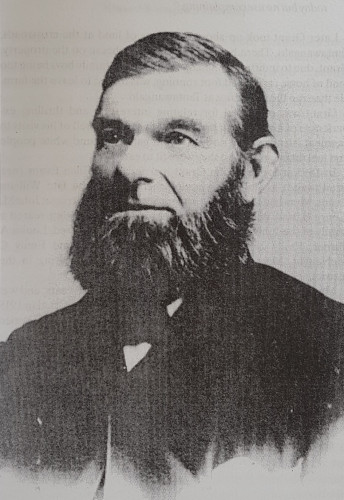South Coast NSW History Story
Captain John Grant, Tantawangalo's First Postmaster
Captain John Grant, Tantawangalo’s First Postmaster
‘Captain John Alfred Sage Grant, a pioneer of Bega and district, was born at Margate, England, in the year 1834. His father was Captain William James Grant, and his mother, Ann (nee Brockman) managed a lodging house in Margate. Grant came from a family of seafarers, with the marine way of life in his veins.
At the age of ten Grant was apprenticed to a chemist but found this life unrewarding. He then went to sea as a cabin boy, but deserted the ship after being cruelly treated. Grant was recaptured and returned to the ship where he was severely flogged, which resulted in life-long scars on his back. A further attempt at desertion proved successful. Acquiring a position on another ship, he found his new master to be much kinder. He then worked his way up to being a mate on the England-Australia run. On one occasion Grant was asked to take charge of the ship during a storm and succeeded in getting the ship safely to port in India. Later he was given charge of one of the company’s ships.
Grant came to Australia as a passenger in 1851 and arrived at Sydney. In that same year he was induced to take a boat into the Bega River, being the first man to enter and investigate it. The mouth was discovered and recorded by Bass. Grant’s purpose was to examine whether or not it would be possible to navigate the river for trading. He writes in a letter to Mr Henry Parbury, dated September 9, 1913,
“There was not at the time a House in South Bega about three in North Bega as I passed onto the river mouth I saw just opposite Mr Rixon House now was a camp two or three slabs on end these were Jock and his mate camp when I called and saw them not a house in the neighboure one of Wararugobrough blong to the Walker that owned the Kamarook Estate.”
For several years Grant traded a ship between Sydney and Pambula, visiting the ports of Tathra and Bermagui. He also assisted in ferrying stone across Merimbula Lake for Munn’s Maizina Works and the Bacon factory. He left the seas, in 1864, and by bullock and dray, and later horse, took supplies from Twofold Bay to Kiandra Goldfields. Grant writes,
“I left off going to sea about year 64 came on land and I regret it today but no use complaining.”
Later Grant took up about 700 acres of land at the crossroads, Tantawangalo. There he dairied and made cheese on the property. Grant, due to indifferent management and the family boys being too fond of horse racing and foot running, was forced to leave the farm. He then ran the post office at Tantawangalo.
Grant was renowned for relating interesting and thrilling experiences of his travels in the old days. He used to tell of his visits to cannibal islands where natives would gather around white people and feel their legs to see if they were fit to eat.
In 1855 at Sydney, Grant married Myra Ellen Evans (nee Braithwaite) a widowed schoolteacher, wife of the late William Evans. Myra had three children from her previous marriage; John M, Henry B and William E Evans. John and Myra Grant reared a family of six; John Richard Grant, Annie Eliza Mussared, Louisa A Turner, Emily J Surplice, Wilfred Alfred Grant and Emily C McNaught. Many of Grant’s descendants are still living in the district.
Myra Grant died in 1892 at Tantawangalo, aged 60 years, and was buried in the Kameruka cemetery. Captain John Grant died in 1919 in the Bega District Hospital at the age of 84 years and was buried next to his wife.’
Source: Volume 1 of ‘Tales of the Far South Coast’
